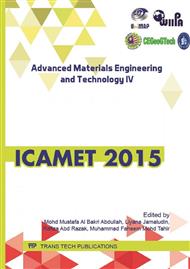[1]
Mei Liquan, Zhao Ke: The influence of arterial stenosis in bifurcate blood vessel on the blood flow[J]. Chinese Journal of Applied mechanics. 2013 Vol. 30 N0. 3, P. 417.
Google Scholar
[2]
Charles. A. Taylor, Thomas. J. R a1. Finite element modeling of blood flow in arteries Computer Methods in Applied Mechanics and Engineering. 1998 P. 156·196.
Google Scholar
[3]
El. Menyaraa, Al. Suwaidi. Jassimtmain, et al. Left main coronary artery stenosis: State-of-the-art [J]. Curr Probl Cardiol, 2007, Vol. 32: 103-193.
DOI: 10.1016/j.cpcardiol.2006.12.002
Google Scholar
[4]
Sianos. G, Papafaklis. M. I, Daemen. J, et al. Angiographic sent thrombosis after routine use of Drug-Eluting sents in ST-segment elevation myocardial Infarction [J]. Journal of American College of Cardiology, 2007, Vol. 50 No. 7: 573-583.
DOI: 10.1016/j.jacc.2007.04.059
Google Scholar
[5]
Grube E, Buellesfeld L, et al. Six-month clinical and angiographic results of a dedicated drug-eluting stent for the treatment of coronary bifurcation narrowing [J]. The American Journal of Cardiology, 2007, Vol. 99: 1691-1697.
DOI: 10.1016/j.amjcard.2007.01.043
Google Scholar
[6]
Hoye. A, Iakovou. I, et al. Long-term outcomes after stenting of bifurcation lesions with the Crush, technique—Predictor of an adverse outcome [J]. Journal of the American College of Cardiology, 2006, Vol. 47 No. 10: 1949-(1958).
DOI: 10.1016/j.jacc.2005.11.083
Google Scholar
[7]
Politis. A. K, Stavropoulos G. P, et al. Numerical modeling of simulated blood flow in idealized composite arterial coronary grafts: Steady state simulations [J]. Journal of Biomechanics, 2007, Vol. 40: 1125-1136.
DOI: 10.1016/j.jbiomech.2006.05.008
Google Scholar
[8]
Jafari. A, Mousavi. S. M, KolariP. Numerical investigation of blood flow. Part I: In micro vessel bifurcations [J]. Communications in Nonlinear Science and Numerical Simulation, 2008, Vol. 13: 1615-1626.
DOI: 10.1016/j.cnsns.2006.09.017
Google Scholar
[9]
O.C. Benolotti, V. Deplano. Three-Dimensional Numerical Simulations of flow through a Stenosed Coronary Bypass., journal of biomechanics. 2001, Vol. 34: 1049-1064.
DOI: 10.1016/s0021-9290(00)00012-9
Google Scholar
[10]
Quarteroni. A. Computational vascular fluid dynamics: problems, models and methods [J]. Computing and Visualization in Science, 2000, Vol. 2: 163-197.
DOI: 10.1007/s007910050039
Google Scholar
[11]
Liu Zhaomiao, Ma Ruiyan et al. Influence of blood flow on thrombosis in Y-shape coronary arteries. Journal of Beijing University of Technology. 2010. Vol. 36 No. 9: 1153-1158.
Google Scholar
[12]
Peng Hongmei, Yang Dequan. the boundary element analysis on Y-bifurcation arterial hemodynamic characteristics. Chinese Journal of Medical Physics. 2011 Vol. 28 No. 5: 2937-2940.
Google Scholar
[13]
Zhang Xujing, Huang Jiuyi et al. Hemodynamics and atherosclerosis. International Journal of Cerebrovascular Disease. 2006. Vol. 14 No. 3: 228-230.
Google Scholar


